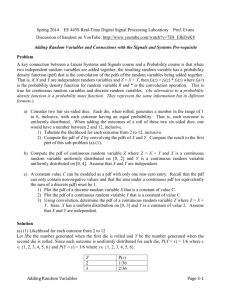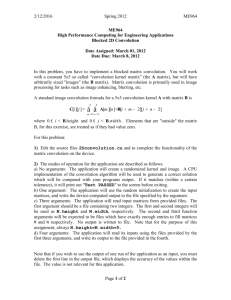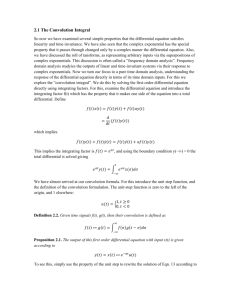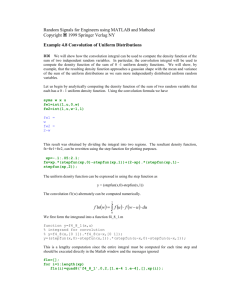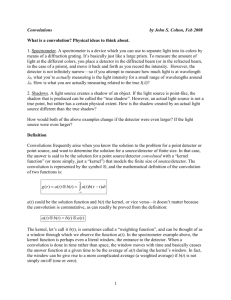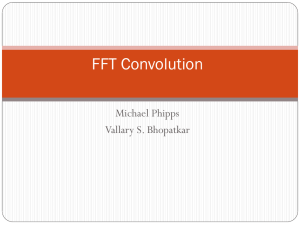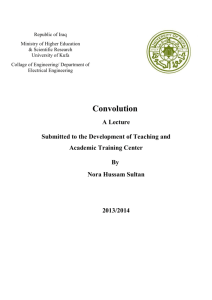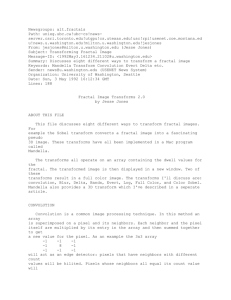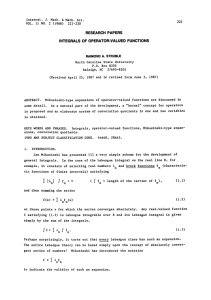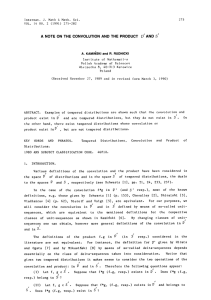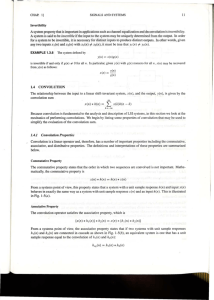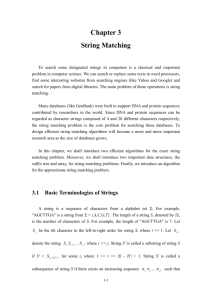Web Appendix D - Derivations of Convolution Properties
advertisement
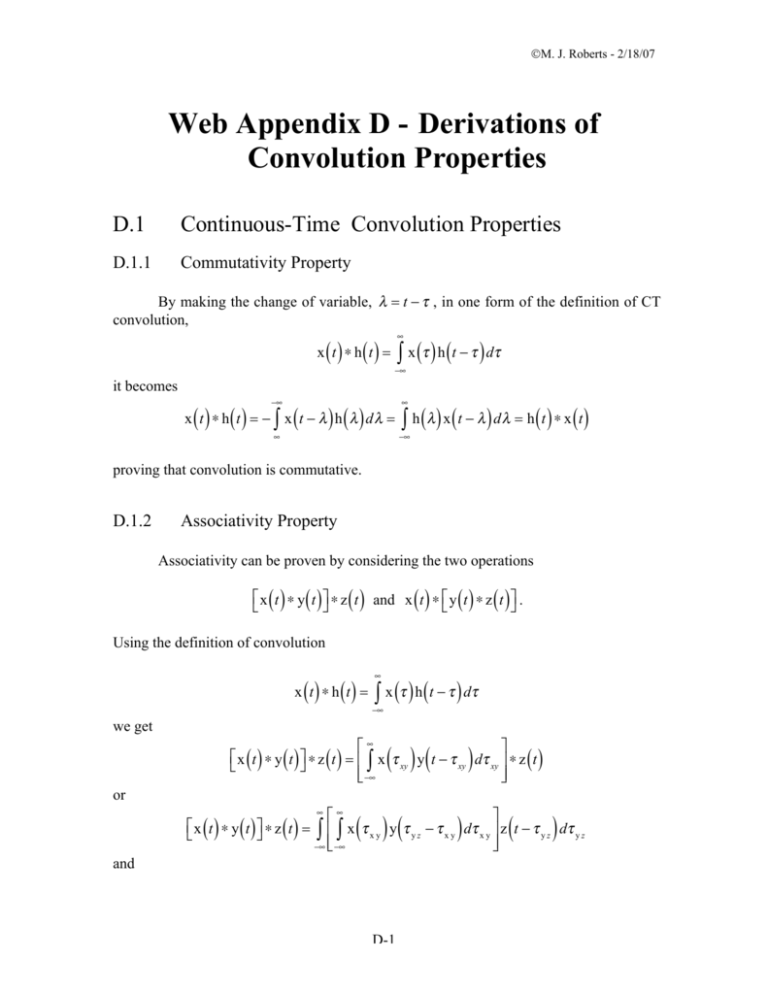
M. J. Roberts - 2/18/07 Web Appendix D - Derivations of Convolution Properties D.1 Continuous-Time Convolution Properties D.1.1 Commutativity Property By making the change of variable, = t , in one form of the definition of CT convolution, ( ) ( ) x ( ) h (t ) d x t h t = it becomes () () ( ) ( ) x t h t = x t h d = h ( ) x (t ) d = h (t ) x (t ) proving that convolution is commutative. D.1.2 Associativity Property Associativity can be proven by considering the two operations () () () () () () x t y t z t and x t y t z t . Using the definition of convolution ( ) ( ) x ( ) h (t ) d x t h t = we get x t y t z t = x xy y t xy d xy z t () () () ( )( ) () or () () () x t y t z t = x y d x y y z x y x y z t y z d y z ( )( and D-1 ) ( ) M. J. Roberts - 2/18/07 x t y t z t = x t y y z z t y z d y z () () () ( )( () ) or () () () x t y t z t = x x y y y z z t x y y z d y z d x y . ( ) ( )( ) Then the proof consists of showing that x ( xy In the ) y ( yz )( ) x y z t y z d x y d y z = right-hand xy x ( xy integration make ) y ( ) z (t yz the xy change ) y z d x y d y z of variable = x y + y z and d = d x y . Then ( )( )( ) x x y y y z x y z t y z d x y d y z = x ( x y integration Next, in the right-hand yz ) y ( ) z (t ) d d yz yz make the change of variable = y z and d = d y z . Then x ( xy ) y ( yz )( ) x y z t y z d x y d y z = x ( ) y ( ) z (t ) d d (D.1) or ( )( )( ) x x y y y z x y z t y z d x y d y z = x ( ) y ( ) z (t ) d d (D.2) Except for the names of the variables of integration, the two integrals (D.1) and (D.2) are the same, therefore the integrals are equal and the associativity of convolution is proven. D.1.3 Distributivity Property Convolution is also distributive, () () () () () () () x t h1 t + h 2 t = x t h1 t + x t h 2 t . () () ( ) x (t ) h (t ) + h (t ) d x t h1 t + h 2 t = 1 D-2 2 M. J. Roberts - 2/18/07 () () () () ( () () x t h1 t + h 2 t = ) x t h1 t d + () () x (t ) h (t ) d 2 () () () x t h1 t + h 2 t = x t h1 t + x t h 2 t D.1.4 Differentiation Property () () () Let y t be the convolution of x t with h t ( ) ( ) ( ) x ( ) h (t ) d . y t = x t h t = () Taking the derivative of y t with respect to time, ( ) x ( ) h (t ) d = x (t ) h (t ) y t = and, invoking the commutativity of convolution, () () () y t = x t h t . D.1.5 Area Property () () () Let y t be the convolution of x t with h t ( ) ( ) ( ) x ( ) h (t ) d . y t = x t h t = () The area under y t is () y t dt = x ( ) h (t ) d dt or, exchanging the order of integration, () y t dt = () ( ) x d h t dt Area of x Area of h proving that the area of y is the product of the areas of x and h. D-3 M. J. Roberts - 2/18/07 D.1.6 Scaling Property () () () () ( ) ( ) Let y t = x t h t and z t = x at h at , a > 0 . Then ( ) x ( a ) h ( a (t )) d . z t = Making the change of variable, = a d = d / a , for a > 0 we get () z t = ( ) ( ) 1 x h at d . a Since ( ) ( ) ( ) x ( ) h (t ) d y t = x t h t = () ( ) ( ) and (1 / a ) y ( at ) = x ( at ) h ( at ) . If we do a similar get (1 / a ) y ( at ) = x ( at ) h ( at ) . Therefore, in general, if it follows that z t = 1 / a y at proof for a < 0 we () () () y t = x t h t then ( ) ( ) ( ) y at = a x at h at . D.2 Discrete-Time Convolution Properties D.2.1 Commutativity Property The commutativity of DT convolution can be proven by starting with the definition of convolution x n h n = and letting q = n k . Then we have x n h n = D.2.2 q = x k h n k k = x n q h q = h q x n q = h n x n q = Associativity Property D-4 M. J. Roberts - 2/18/07 If we convolve g n = x n y n with z n we get g n z n = x n y n z n = x k y n k z n k = ( ) g n or g n z n = x k y q k z n q q = k = g q Exchanging the order of summation, ( x n y n ) z n = x k y q k z n q k = q = Let n q = m and let h n = y n z n . Then ( x n y n ) z n = x k z m y ( n k ) m k = m= z n y n k = y n k z n = h n k or ( x n y n z n = x k h n k = x n y n z n k = h n ) x n h n D.2.3 Distributivity Property If we convolve x n with the sum of y n and z n we get ( ) x k ( y n k + z n k ) x n y n + z n = k = or ( ) x k y n k + x k z n k . x n y n + z n = k = = x n y n Therefore ( ) k = = x n z n x n y n + z n = x n y n + x n z n . D-5 M. J. Roberts - 2/18/07 D.2.4 Differencing Property Let y n = x n h n . Using the time-shifting property y n n0 = x n h n n0 = x n n0 h n the first backward difference of their convolution sum is y n y n 1 = x n h n x n h n 1 or y n y n 1 = x m h n m m= x m h n m 1 . m= Combining summations, x m ( h n m h n m 1 ) y n y n 1 = m= or ( y n y n 1 = x n h n h n 1 D.2.5 ) Sum Property Let y n = x n h n and let the sum of all the impulses in the functions y, x, and h be S y , S x and S h , respectively. Then y n = x m h n m m= and Sy = n= y n = x m h n m . n= m= Interchanging the order of summation, Sy = x m h n m = S S m= n= = Sx = Sh D-6 x h .
